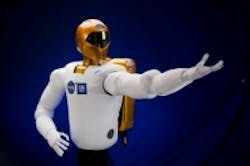NASA’s Robonaut 2 humanoid robot learning emergency medical skills
NASA researchers are training the Robonaut 2 (R2) space robot—which is designed to work alongside astronauts in space—to learn certain medical procedures in the event of an emergency.
The $2.5 million Robonaut is a 330-pound, 3'4" (from the waist to head) robot made of aluminum and steel. It has more than 38 PowerPC processors that control the robot, as well articulating fingers and thumbs. A backpack houses the robots power conversion system or batteries and each 2'8" arm can hold up to 20 pounds. The robot’s vision system consists of four stereo cameras and an infrared camera, which is used for depth perception.
R2 is the first humanoid robot ever to fly in space. Currently, the robot is located at the International Space Station, where astronauts are testing its abilities to help with multiple tasks both inside and outside the station. In a video posted by NASA, Robonaut 2 is shown performing telemedicine training, including an automated ultrasound scan and an injection, both of which were done on a mannequin. Robonaut 2 being trained to administer such care to astronauts via physicians controlling the robots from the ground, according to Space.com.
Preliminary telemedicine tests performed by R2 have shown that human controllers can perform tasks "correctly and efficiently by using R2's dexterity to apply the appropriate level of force and can track their progress using R2's vision system," according to NASA. Telemedicine skills like these would also prove useful on Earth, in that physicians would be able to conduct complex medical procedures on humans in remote locations.
View more information on Robonaut 2.
Also check out:
Google working with Foxconn on automation robots
(Slideshow) 10 innovative current and future robotic applications
Australian astronomers discover oldest known star in the Universe
Share your vision-related news by contactingJames Carroll, Senior Web Editor, Vision Systems Design
To receive news like this in your inbox, click here.
Join our LinkedIn group | Like us on Facebook | Follow us on Twitter | Check us out on Google +
About the Author

James Carroll
Former VSD Editor James Carroll joined the team 2013. Carroll covered machine vision and imaging from numerous angles, including application stories, industry news, market updates, and new products. In addition to writing and editing articles, Carroll managed the Innovators Awards program and webcasts.
